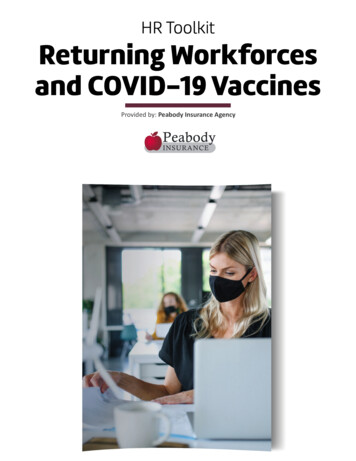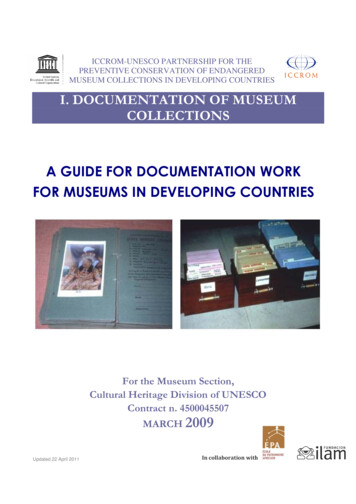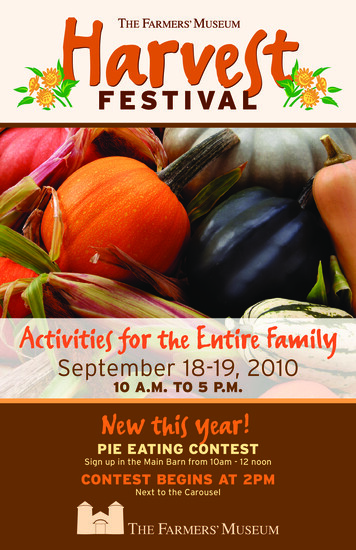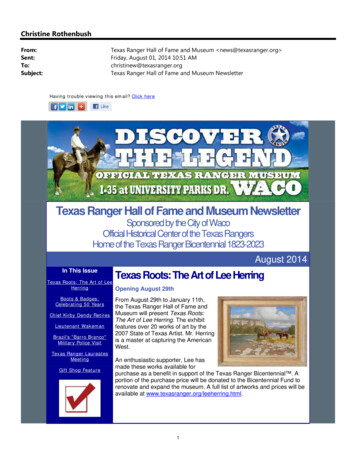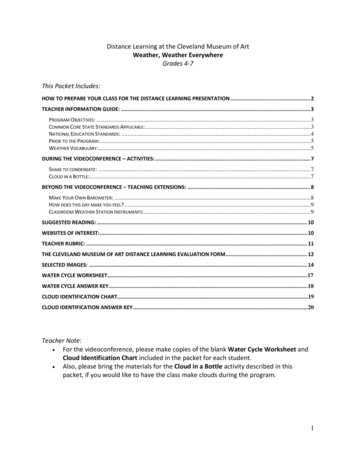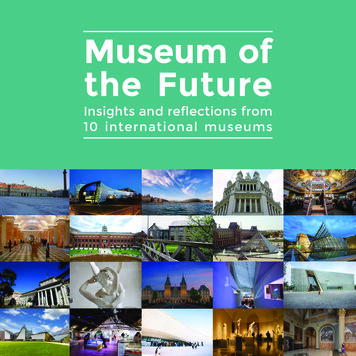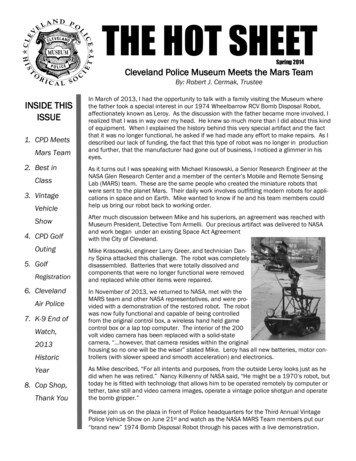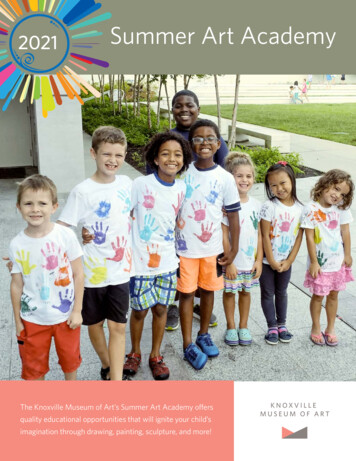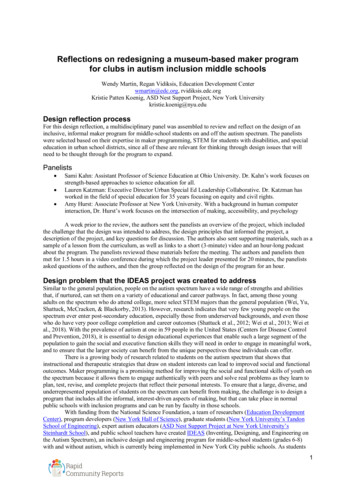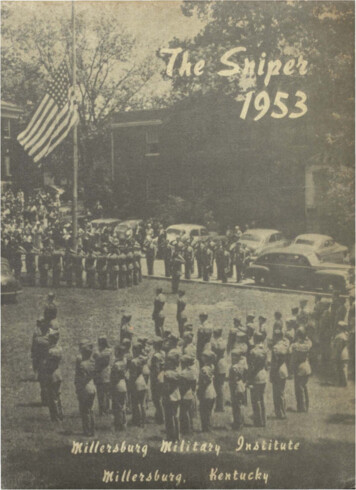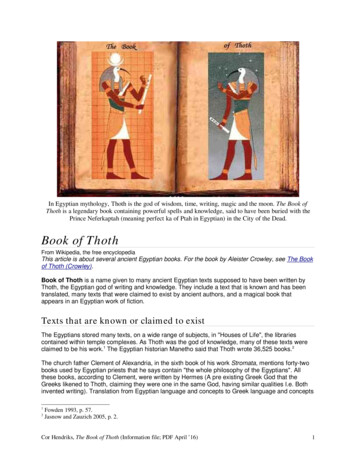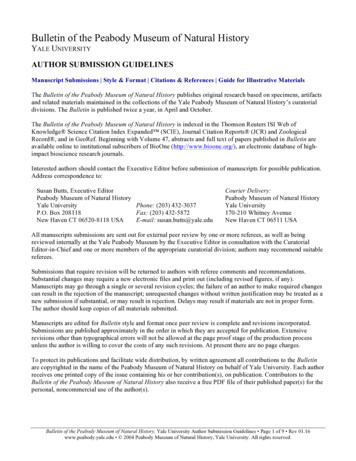
Transcription
Bulletin of the Peabody Museum of Natural HistoryYALE UNIVERSITYAUTHOR SUBMISSION GUIDELINESManuscript Submissions Style & Format Citations & References Guide for Illustrative MaterialsThe Bulletin of the Peabody Museum of Natural History publishes original research based on specimens, artifactsand related materials maintained in the collections of the Yale Peabody Museum of Natural History’s curatorialdivisions. The Bulletin is published twice a year, in April and October.The Bulletin of the Peabody Museum of Natural History is indexed in the Thomson Reuters ISI Web ofKnowledge Science Citation Index Expanded (SCIE), Journal Citation Reports (JCR) and ZoologicalRecord , and in GeoRef. Beginning with Volume 47, abstracts and full text of papers published in Bulletin areavailable online to institutional subscribers of BioOne (http://www.bioone.org/), an electronic database of highimpact bioscience research journals.Interested authors should contact the Executive Editor before submission of manuscripts for possible publication.Address correspondence to:Susan Butts, Executive EditorPeabody Museum of Natural HistoryYale UniversityPhone: (203) 432-3037P.O. Box 208118Fax: (203) 432-5872New Haven CT 06520-8118 USAE-mail: susan.butts@yale.eduCourier Delivery:Peabody Museum of Natural HistoryYale University170-210 Whitney AvenueNew Haven CT 06511 USAAll manuscripts submissions are sent out for external peer review by one or more referees, as well as beingreviewed internally at the Yale Peabody Museum by the Executive Editor in consultation with the CuratorialEditor-in-Chief and one or more members of the appropriate curatorial division; authors may recommend suitablereferees.Submissions that require revision will be returned to authors with referee comments and recommendations.Substantial changes may require a new electronic files and print out (including revised figures, if any).Manuscripts may go through a single or several revision cycles; the failure of an author to make required changescan result in the rejection of the manuscript; unrequested changes without written justification may be treated as anew submission if substantial, or may result in rejection. Delays may result if materials are not in proper form.The author should keep copies of all materials submitted.Manuscripts are edited for Bulletin style and format once peer review is complete and revisions incorporated.Submissions are published approximately in the order in which they are accepted for publication. Extensiverevisions other than typographical errors will not be allowed at the page proof stage of the production processunless the author is willing to cover the costs of any such revisions. At present there are no page charges.To protect its publications and facilitate wide distribution, by written agreement all contributions to the Bulletinare copyrighted in the name of the Peabody Museum of Natural History on behalf of Yale University. Each authorreceives one printed copy of the issue containing his or her contribution(s), on publication. Contributors to theBulletin of the Peabody Museum of Natural History also receive a free PDF file of their published paper(s) for thepersonal, noncommercial use of the author(s).Bulletin of the Peabody Museum of Natural History, Yale University Author Submission Guidelines Page 1 of 9 Rev 01.16www.peabody.yale.edu 2004 Peabody Museum of Natural History, Yale University. All rights reserved.
Manuscript SubmissionsManuscripts are always to be submitted in a standard PC or Macintosh-based word processing format. Small filesmay be sent as attachments to e-mail; large files may be submitted using Yale University’s free file transferfacility (contact the publications Office for instructions) or other online transfer site. Keep copies of all files.Include all graphics files (illustrations, photographs) as separate digital files with initial submission, so that anyresolution or compatibility issues can be assessed (see below for requirements or contact the Publications Officefor guidance). The Yale Peabody Museum reserves the right to reject figures and manuscripts that do not conformto these requirements.Manuscripts will be copyedited and formatted for publication once the review process is complete and allrevisions have been incorporated by the author(s). Substantial changes may require new electronic files (includingrevised figures, if any). Delays may result if materials are not in proper form.Page proofs of the copyedited and formatted manuscript are sent to the lead author for final approval. This proofcopy is for checking printer’s errors only and to resolve any queries or missing information; only trivial revisionscan be made at this stage. Contributors will be charged for excessive revisions. Corrected page proofs must bereturned to the Publications Office within seven (7) days.Style & FormatThe Yale Peabody Museum uses the latest edition of Scientific Style and Format: The CBE Manual for Authors,Editors, and Publishers (http://www.councilscienceeditors.org/), as its primary style manual, along with TheChicago Manual of Style (16th ed.). See these references for specific recommendations and examples of thefollowing guidelines. The Publications Office reserves the right to adjust style and form to meet the specificationsof the Yale Peabody Museum publications.TitlesArticle titles should be short (max. 20 words), precise and straightforwardly descriptive, succinctly conveying themanuscript’s content. Include pertinent keywords that will facilitate computerized listings. Names of new taxashould not appear in the title. Abbreviations, acronyms and hyphenated terms should be avoided, and punctuationkept to a minimum. Provide titles and captions for all figures and tables in separate files.Author AffiliationProvide the full name, institutional affiliation and contact information for each author, including mailing and email addresses; indicate which author should be designated the corresponding author.AbstractAn informative abstract of up to 300 words for the Bulletin should precede the text and conform to therequirements of BioAbstracts. Do not use abbreviations, acronyms and citations unless widely understood (e.g.,DNA, pH). Authors have the option of also including foreign language abstracts as appropriate.KeywordsFollowing the abstract, provide up to 10 keywords or terms not appearing in the title, indicating the central topicsof the publication, to facilitate computerized document retrieval.Bulletin of the Peabody Museum of Natural History, Yale University Author Submission Guidelines Page 2 of 9 Rev 01.16www.peabody.yale.edu 2004 Peabody Museum of Natural History, Yale University. All rights reserved.
NomenclatureThe first mention of an animal or plant in the text should include the full scientific name and other pertinentattribution. All generic and specific names should be italicized. Nomenclature should conform to the currently inforce International Code of Zoological Nomenclature for zoological works and the International Code ofBotanical Nomenclature for botanical works.TextAuthors should write with precision, clarity and economy; use the active voice and first person. Mainheadings (for example, “Introduction,” “Materials and Methods,” “Results,” “Discussion”) and subheadings thatdelimit different sections within the text should be explicit, descriptive, and as short as possible; hierarchicallevels should be parallel and consistent throughout the manuscript. Avoid using more than four levels.Avoid abbreviations and acronyms unless well established and used widely in the scientific literature (forexample, DNA, pH). Define parenthetically less widely used acronyms and abbreviations that appear more than afew times at first use. Avoid the excessive use of Latin terms. Institutional abbreviations and acronyms, such as incatalog numbers, should be listed and defined in the Materials and Methods section of the article.Give measurements in metric (SI) units, time in terms of the 24 hour clock (0930 h, not 9:30 a.m.); temperature indegrees Celsius (32 ºC); dates as 16 February 2004. See the guidelines given in Scientific Style and Format forspecific examples. Do not use all capital letters for titles, headings or subheadings. Italicize only as needed forcontent (such as species names, non-English terms), otherwise do not include underlines, bold, italic or otherformatting in the text. Indicate any special characters, accents and symbols in the margins of the manuscript.Complex mathematical formulas should be provided as separate image files. Any special fonts used must beflagged in the manuscript and noted in the author’s submission letter so that the Publications Office can ensurespecial characters print correctly.Yale Peabody Museum catalog numbers should follow the 6-digit format with division designation used in theYPM collections management database, as follows: YPM DIV 000000. Use full numbers in ranges. Examples:YPM ANT 017898YPM VPPU 016235, 016245YPM HERR 003873–003881CaptionsCaptions are to provide all explanatory text for figures and tables; do not use titles, legends and footnotes in theimage itself. Provide a short introductory phrase or a formal title for each figure, table or appendix; avoidexcessive wording. All illustrations and photographs are to be called “Figures” and should be numberedconsecutively using Arabic numerals. Use uppercase letters in a common sans serif font (such as Helvetica,Myriad or Arial) for labels within a figure; do not use special graphic effects such as shadows or outlining.Number tables separately from figures. Submit captions double-spaced in a clearly labeled separate electronic file(not attached to illustrations or tables), with a separate paragraph devoted to each figure or table number.Credit for illustrations or photographs that are not your own must be provided for each figure, or listed in theacknowledgments. Provide copyright information if you are not the copyright holder, along with a writtenstatement of permission to reproduce the material (see below). Note that it is the responsibility of the authors tomake copyright holders aware that Bulletin articles are made available online after publication and that suchpermission statements should grant both print and electronic worldwide rights in perpetuity.Acknowledge sources for figures based on other work with “From Smith 2001” for work substantially reprintedas first published, or with “Modified from Smith 2001” for work adapted from previously published material withchanges.Bulletin of the Peabody Museum of Natural History, Yale University Author Submission Guidelines Page 3 of 9 Rev 01.16www.peabody.yale.edu 2004 Peabody Museum of Natural History, Yale University. All rights reserved.
FootnotesExcept in rare cases, footnotes should not be used, but incorporated into the text. If unavoidable, they should bekept to a minimum and be submitted double-spaced on in a separate electronic file. Footnotes can be used intables, especially to designate source materials.AcknowledgmentsAcknowledgment should include information on granting agencies, and on individuals and institutions that havelent or provided access to materials, specimens, financial support, field assistance or editorial review, amongothers. Provide grant numbers when available. Spell out institution and agency namesAlso include here the names of illustrators and photographers of work used in the article that is not by theauthor(s). Written permission to reproduce any copyrighted material must be submitted with the manuscript, andproper credit included in figure captions or in the acknowledgments (see above).Type Material & VouchersWhenever possible, all primary name-bearing types (such as holotypes, neotypes, lectotypes) based on YalePeabody Museum specimens designated in the Bulletin scholarly publications should be deposited in theappropriate collection at the Yale Peabody Museum. Secondary types (such as paratypes) should be deposited inmajor institutional collections. Voucher specimens arising from the ecological or related work should bedeposited in whole or major part in the appropriate collection at the Yale Peabody Museum.AuthorshipAuthors named on manuscript submissions must have played a significant role in the research, writing, and in theguidance of the research being reported. Those whose role involved providing materials, specimens, financialsupport, field assistance or review should be recognized in the acknowledgments.CopyrightAll scholarly publications are copyrighted in the name of the Peabody Museum of Natural History onbehalf of Yale University. To protect its publications and facilitate wide distribution, it is the policy ofthe Yale Peabody Museum to require that contributors assign their copyright interests in their work tothe Yale Peabody Museum, including electronic rights, and rights in all renewals and extensions ofcopyright. The Yale Peabody Museum in turn grants contributors the right to re-use their work providedthat all such use is for the personal noncommercial benefit of the author(s). The signed publicationagreement must be received before publication.Bulletin of the Peabody Museum of Natural History, Yale University Author Submission Guidelines Page 4 of 9 Rev 01.16www.peabody.yale.edu 2004 Peabody Museum of Natural History, Yale University. All rights reserved.
Citations & Literature CitedCitations in the text and Literature Cited reference listings for the most part follow the guidelines for the nameyear system given in Scientific Style and Format: The CBE Manual for Authors, Editors, and Publishers and,secondarily, The Chicago Manual of Style. Every citation in the text must be referenced in the reference list,including references to internet sources and databases. Provide URLs for all web references, including date ofaccess, and availability information for hard-to-find sources. Unpublished material should be cited as (Smith,pers. obs.), (Smith 1999, pers. comm.) or (Smith, unpubl. data) in the text, but not included in the Literature Citedlist. For examples see below, or reference the Scientific Style and Format.Citation & Reference ExamplesList citations in the text chronologically from earliest to latest; citations in the same year are listed alphabetically.For citations in the text whenever the author’s name appears as part of the sentence structure:Smith (1963)Jones et al. (1977, 1985a, 1985b)otherwise use the format:Scudder 1889; Mayr 1963; Jones et al. 1985a, 1985b; Straus and Sandler 1989For articles with multiple authors but the same year, list as many authors as necessary to distinguish thecitations.Gupta, Collinson et al. 2006Gupta, Michels et al. 2006Citations for specific pages and figures should use the format:Mayr (1963:236, fig. 4)Mayr (1963, pl. 4)List references in the Literature Cited alphabetically, and chronologically from earliest to latest for identicalauthor(s) listings; references in the same year with the same author(s) are designated as 2010a, 2010b, etc.Provide the names of all authors, editors and translators as appropriate (use “et al.” or “and others” for namesbeyond the 10th).Spell out journal titles in full. Use lowercase sentence format for journal articles, upper/lowercase title case forbook titles; do not italicize.AbstractTornow, M. A. 2001. The utility of dental data in reconstruction omomyid phylogeny: an analysis usingoutgroup swapping [abstract]. In: Abstracts of AAPA Poster and Podium Presentations, Program of the 70thAnnual Meeting of the American Association of Physical Anthropologists; 2001 Mar 28-31; Kansas City,MO. American Journal of Physical Anthropology 114(32Suppl):150-151. Published online 13 Mar 2001.Available from: http://physanth.org/annmeet/Bulletin of the Peabody Museum of Natural History, Yale University Author Submission Guidelines Page 5 of 9 Rev 01.16www.peabody.yale.edu 2004 Peabody Museum of Natural History, Yale University. All rights reserved.
BookSimpson, G. G. 1953. The Major Features of Evolution. New York: Columbia University Press. 434 pp.Boschung, H. T. Jr. and R. L. Mayden. 2004. Fishes of Alabama. Washington, DC: Smithsonian Books. 736pp.Book chapterFitzpatrick, J. W. 2004. Family Tyrannidae (tyrant-flycatchers). In: J. del Hoyo, A. Elliott and D. Christie, eds.Handbook of the Birds of the World, Volume 9. Barcelona: Lynx Edicions. pp. 170–463.Book in a seriesBierwirth, S. L. 1996. Lithic Analysis in Southwestern France: Middle Paleolithic Assemblages from the Siteof La Quina. Oxford: Tempus Reparatum. 75 pp. (BAR International Series 633).Carr, A. F. Jr., A. Meylan, J. Mortimer, K. Bjorndal and T . Carr. 1982. Surveys of sea turtle populations andhabitats in the western Atlantic. Panama City, FL: US Dept. of Commerce, National Oceanic andAtmospheric Administration, National Marine Fisheries Service. 91 pp. (NOAA Technical MemorandumNMFS/SEFC-91.)Computer programSAS Institute. 2003. SAS for Windows [computer program]. Version 9.1. Cary, NC: SAS Institute.[NIH] National Institutes of Health. 1999. NIH Image [computer program]. Version 1.62. Bethesda, MD:NIH, National Institute of Mental Health, Research Services Branch. Available from:http://rsb.info.nih.gov/nih-image/Swofford, D. L. and D. P. Begle. 1993. PAUP* Phylogenetic Analysis Using Parsimony. Version 3.1. User’sManual [internet]. Washington, DC: Smithsonian Institution, Laboratory of Molecular Systematics. 280 pp.Available from: http://paup.csit.fsu.edu/Paup Doc 31.pdfConference proceedingsEvers, B. and J. Manley. 2007. A vehicle for science and exploration: bringing offshore industry advancesand experience to the oceanographic community. In: Oceans 2007; proceedings; Vancouver, BC, Canada; 29Sept–4 Oct 2007. Piscataway, NJ: IEEE. pp. 1-6. Available from: IEEE mber 4446228Nessov, L. A. and L. I. Khozatsky. 1973. [Early Cretaceous turtles from southeastern Fergana.] In: I. S.Darevskiĭ. Voprosy gerpetologii: avtoreferaty dokladov; vsesoiuznaia gerpetologicheskaia konferentsiia [TheProblems of Herpetology; proceedings of the Third All-Union Herpetological Conference]; 1973 Feb 1–3;Leningrad (St. Petersburg). Leningrad: Nauka, Leningradskoe otd-nie. pp. 132–133. (in Russian)DatabaseHickey, L. J., L. S. Klise and W. S. Green. 2006. The Yale–Princeton Compendium Index ofNorth American Mesozoic and Cenozoic Type Fossil Plants [electronic database]. Release 1.0.[2006 Jan 11]. New Haven: Peabody Museum of Natural History, Yale University. Availablefrom: 0/DissertationSweeney, P. W. 2007. Systematics and floral evolution in the plant genus Garcinia (Clusiaceae)[dissertation]. Saint Louis: University of Missouri–Saint Louis. Available from: ProQuest Dissertations& Theses [online database]; http://www.proquest.com (publication number AAT 3323336).Bulletin of the Peabody Museum of Natural History, Yale University Author Submission Guidelines Page 6 of 9 Rev 01.16www.peabody.yale.edu 2004 Peabody Museum of Natural History, Yale University. All rights reserved.
Internet articleJablonski, N. 2004. Putting technology to work at Koobi Fora. KFRP Field Season Dispatches [internet].Kenya: Koobi Fora Research Project; [cited 19 April 2006]. Available from:http://www.kfrp.com/dispatches 2004/gis jablonski/gis jablonski.htmInfoNatura. 2007 April 10. Animals and Ecosystems of Latin America [internet]. Version 5.0. Arlington, VA:NatureServe. [c2007; updated April 2007; accessed 12 October 2009]. Available from:http://www.natureserve.org/infonaturaInternet database[ePic] Electronic Plant Information Centre [internet database]. 2002. Richmond, England: Royal BotanicGardens, Kew. [cited 28 Mar 2003]. Available from: http://www.kew.org/epic/Internet web pageInfoNatura. 2007 April 10. Animals and Ecosystems of Latin America [internet]. Ver
may be sent as attachments to e-mail; large files may be submitted using Yale University’s free file transfer facility (contact the publications Office for instructions) or other online transfer site. Keep copies of all files. Include all graphics files (illustrations, photographs) as se
